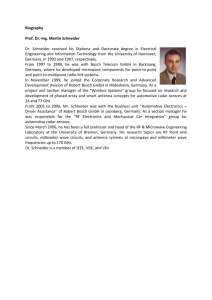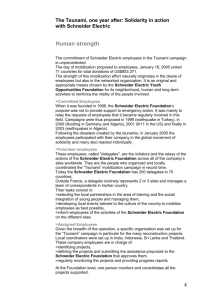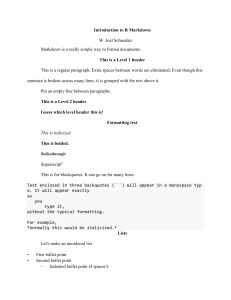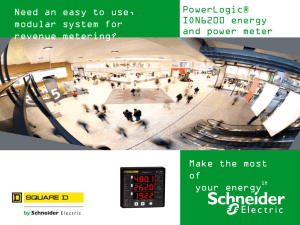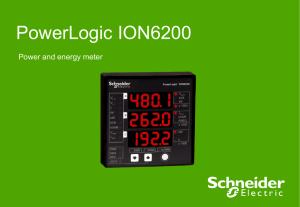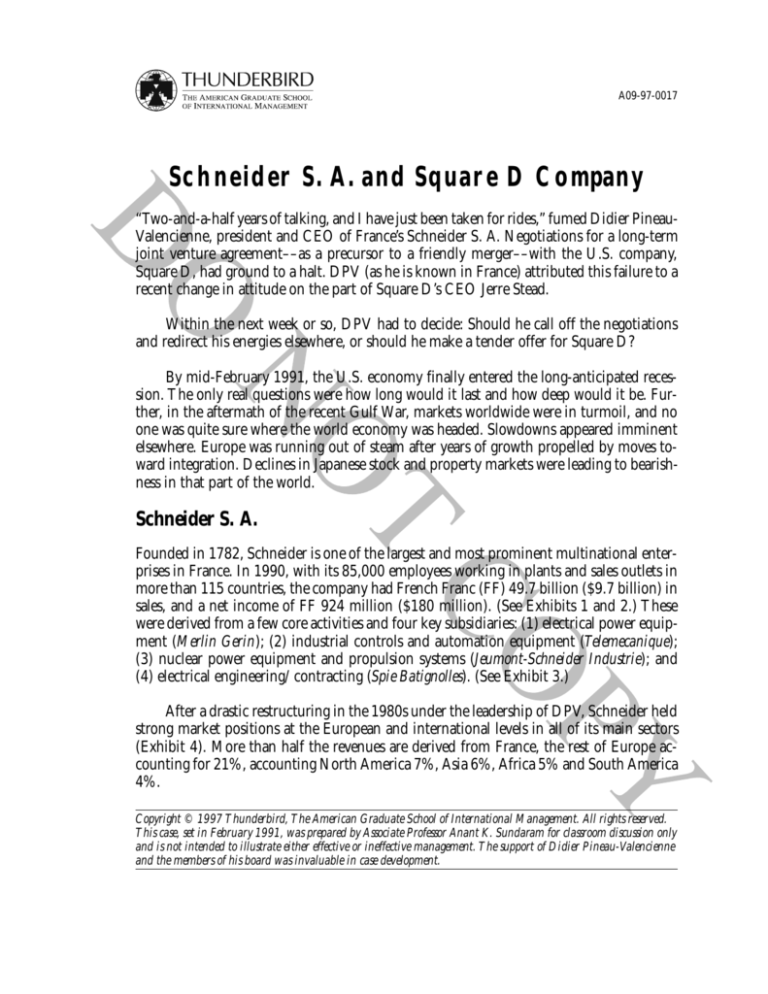
A09-97-0017
Schneider S. A. and Square D Company
“Two-and-a-half years of talking, and I have just been taken for rides,” fumed Didier PineauValencienne, president and CEO of France’s Schneider S. A. Negotiations for a long-term
joint venture agreement––as a precursor to a friendly merger––with the U.S. company,
Square D, had ground to a halt. DPV (as he is known in France) attributed this failure to a
recent change in attitude on the part of Square D’s CEO Jerre Stead.
Within the next week or so, DPV had to decide: Should he call off the negotiations
and redirect his energies elsewhere, or should he make a tender offer for Square D?
By mid-February 1991, the U.S. economy finally entered the long-anticipated recession. The only real questions were how long would it last and how deep would it be. Further, in the aftermath of the recent Gulf War, markets worldwide were in turmoil, and no
one was quite sure where the world economy was headed. Slowdowns appeared imminent
elsewhere. Europe was running out of steam after years of growth propelled by moves toward integration. Declines in Japanese stock and property markets were leading to bearishness in that part of the world.
Schneider S. A.
Founded in 1782, Schneider is one of the largest and most prominent multinational enterprises in France. In 1990, with its 85,000 employees working in plants and sales outlets in
more than 115 countries, the company had French Franc (FF) 49.7 billion ($9.7 billion) in
sales, and a net income of FF 924 million ($180 million). (See Exhibits 1 and 2.) These
were derived from a few core activities and four key subsidiaries: (1) electrical power equipment (Merlin Gerin); (2) industrial controls and automation equipment (Telemecanique);
(3) nuclear power equipment and propulsion systems (Jeumont-Schneider Industrie); and
(4) electrical engineering/ contracting (Spie Batignolles). (See Exhibit 3.)
After a drastic restructuring in the 1980s under the leadership of DPV, Schneider held
strong market positions at the European and international levels in all of its main sectors
(Exhibit 4). More than half the revenues are derived from France, the rest of Europe accounting for 21%, accounting North America 7%, Asia 6%, Africa 5% and South America
4%.
Copyright © 1997 Thunderbird, The American Graduate School of International Management. All rights reserved.
This case, set in February 1991, was prepared by Associate Professor Anant K. Sundaram for classroom discussion only
and is not intended to illustrate either effective or ineffective management. The support of Didier Pineau-Valencienne
and the members of his board was invaluable in case development.
Until 1980, Schneider was largely under the control of the Belgian family, the Empains.
Over the past two centuries, the company had become, in the words of Michel-Francois
Poncet of the French bank, Banque Paribas (a board member of Schneider), “an antiquated
department store of unrelated family activities.” It had a substantial investment in such
loss-making areas as shipbuilding and steel.
In addition, the owner Baron Empain diversified the company into non-related sectors such as sports equipment, publishing, real estate, advertising and packaging. This diversification strategy was worsened by weak financial and operating controls, and the fact
that as the main shareholder, Baron Empain, was unable to meet the group’s financial needs.
In 1981, Baron Empain asked DPV (previously an employee of Schneider and subsequently of the French chemicals giant Rhone-Poulenc) to take responsibility for turning the
group around. The Chicago Tribune wrote in February 1991:
“When Didier Pineau-Valencienne left Rhone-Poulenc to head the troubled steel maker
Empain-Schneider ten years ago, colleagues gave him a telling going-away gift: a big
movie poster for a spaghetti western with star Henry Fonda saying, I shoot first. Since
then Pineau-Valencienne has lived up to the poster’s image...in aggressively reshaping
Group Schneider into a major player in the electrical equipment industry.
Educated at Dartmouth College’s Amos Tuck School of Business Administration,
Pineau-Valencienne switched from an early career in publishing where this amateur
poet made a mark by negotiating rights to publish Albert Camus’ novel ‘The Fall’ in
the U.S. to restructuring sick businesses. The first of those was Empain-Schneider in
the late 60s, then came Rhone-Poulenc in the 70s, and finally a return to EmpainSchneider in the 80s. In the process he earned such unflattering names as Doctor Atilla
and DPV the Destroyer.”
Jean-Leon Vandoorne, the associate chief editor of the largest financial daily in France,
Les Echos, doesn’t agree: “DPV is one of the most modest and straightforward managers I
know. He tells you what he means and doesn’t give you the run-around.”
DPV set out to restructure Schneider, and despite protests from the labor unions and
the French government, sold businesses that did not fit his plan to refocus the company on
its core electrical products and construction businesses. During the period from 1981 to
1988, Schneider built a strong base through a set of aggressive acquisitions in France and
abroad. Between 1986 and 1990, Schneider invested FF 23 billion ($4.5 billion) in acquisitions, FF 8.3 billion ($1.62 billion) in capital expenditures and FF 7 billion ($1.36 billion) in R&D. As the company’s 1990 Annual Report noted:
“The Schneider group is dedicating a very considerable part of its resources to strengthening its position as a world leader in....electrical distribution and automation equipment, markets which are undergoing rapid globalization. Economies of scale are of
critical importance....[and] research and development expenditures in the power distribution and automation spheres are substantial and fast growing, requiring significant market shares over which to spread these expenses. Global integration is speeding
up as national standards are rapidly being supplanted by international ones. From its
2
A09-97-0017
solid European base, Schneider has in particular set goals to strengthen its presence in
North America, which accounts for one-quarter of world sales....”
During this period, DPV was backed in his efforts by supportive and stable shareholders. Further, they have been ready and willing to provide the capital necessary for Schneider’s
expansion efforts. For example, in June 1990, Schneider issued FF 3 billion ($584.9 million) in convertible bonds with redeemable share purchase warrants, approximately half of
which was bought by the group’s principal shareholder.
Given Schneider’s relatively feeble presence in North America, DPV had been contemplating a major investment in the U.S. market. The barrier to large-scale entry in the
U.S. was distribution, which would be too costly to build de novo. Among the options
under scrutiny, Square D, the last major independent producer of electrical distribution
and automation equipment in the U.S., was regarded by DPV as an attractive potential
target for a strategic alliance.
Square D Company
Square D, founded in 1903, is a publicly held electrical distribution and industrial control
equipment producer with operations mainly in the U.S. Square D operates thirty-five domestic and eighteen international facilities with 18,500 employees (including 4,000 based
abroad). The company has been profitable for the last fifty-nine years, and 1990 marked
the fifth consecutive year of record sales ($1,653 million, compared to $1,598 million in
1989: Exhibit 5). The electrical distribution business segment accounted for 70% of sales
and 83% of profits; operations in the U.S. market accounted for approximately 80% of
sales and 92% of profits (see Exhibit 6 for information on its product range). However, the
company has significant market positions in Mexico, Canada, the UK, Thailand and Australia.
In both commercial and residential electrical distribution equipment, Square D is the
market leader in the U.S. (ahead of General Electric (GE) and Westinghouse). It is number
three in industrial electrical distribution equipment (after Westinghouse and General Electric), and number two in electromechanical industrial control equipment (after Allen Bradley).
In 1990, Square D had a net income of $120.7 million ($101.9 million in 1989),
although between 1985 and 1990, its operating margins declined from around 16% of sales
to around 11%. The company attributed this decline to shifts in product mix (resulting in
a lowered share of high margin products), increased efforts at internationalization (resulting in a higher share of low margin products), higher selling expenses (reaching 14% of
sales), and losses of $30 million from some business segments.
In October 1990, Square D’s stock was selling at a little over $35 on the New York
Stock Exchange; by mid-February 1991, the price had risen to over $50, with the market
anticipating some kind of move on Schneider’s part. Square D has a beta of 1.02, measured
against the U.S. market portfolio (the beta is a measure of the expected percentage moveA09-97-0017
3
ment in a firm’s stock returns for each percentage movement in the expected returns on a
well-diversified portfolio of stocks, known as the “market” portfolio).
The company sells its branded products at a premium compared to its competition.
The company’s logo (a capital D embedded in a square) has become a familiar symbol
associated with circuit breakers found in the basements of millions of American homes.
With over 1200 distributors––most of them independent, and not captive––located all
over the U.S., Square D has one of the best selling networks in the industry. The company
backs up its distribution network with a strong and well-trained sales force.
The current CEO, Jerre Stead, was recruited as president and COO in 1986, from
Honeywell Inc., where he had spent 21 years. He was credited with the turnaround of
Honeywell’s residential products division in 1982-83, in the midst of a recession.
Stead planned to turn Square D into a major global player, and described the culture
he wanted to foster in the company as one of being dedicated to growth and committed to
quality, with strong cash flows and a conservative balance sheet. In 1990, Square D spent
$94 million on capital expenditures and $55 million on R&D, on sales of $1,653 million.
It had cash and cash equivalents of $245 million on its balance sheet, and the ratio of debt
to year-end market value of equity was 22% (10% in 1989). Comparable financial data on
Square D and its competitors are provided in Exhibit 7.
The Joint Venture Negotiations
By the late 1980s, the electrical distribution industry was globalizing rapidly, and most of
Schneider’s leading competitors––notably Asea Brown Boveri (ABB) of Sweden––were
making significant resource commitments in the U.S. Given the relatively weak position
that Schneider had in a market that accounted for a quarter of world sales and the intense
competition for market share among the leading players, DPV had to think of ways to
expand his presence in the U.S. Otherwise, Schneider could be left behind. DPV noted,
“.....all my competitors came to the same conclusion; it is a rapidly changing market that is
globalizing. The creation of ABB forced us to question our industry and its operations in a
rather fundamental way.”
In order to establish a foothold in the North American market, Schneider acquired the
Canadian company Federal Pioneer for FF 1.4 billion ($273 million) in 1990. Earlier, in
1987, they acquired Federal Pacific in Mexico. However, given their relatively small size,
these acquisitions were ineffective as platforms for U.S. entry. DPV then looked to GE and
Westinghouse to examine prospects of joint venture agreements, but both these efforts fell
through.
A 1988 study done for Schneider by the U.S. consulting firm McKinsey and Co.
identified three firms as potential partners for Schneider in the U.S.: Cutler Hammer, Crouse
Hinds, and Square D. Of the three, Square D appeared to be the firm that offered the
greatest complementaries (see Exhibit 8). In September of 1988, Schneider hired the New
4
A09-97-0017
York investment banking firm Dillon Read to help initiate a joint venture discussion with
Square D.
From the start, Stead made it clear that it was crucial for Square D to remain independent. Anything that involved a loss of independence would be vetoed by his board. DPV
agreed to this, and in a letter to Stead in 1989, committed himself to “...expressly exclude
any hostile operation,” and informed the directors of Square D that he would not pursue
any transaction that was not approved by them. Further, he made a personal commitment
to Stead that he would not purchase a single share of Square D stock in the open market.
However, negotiations broke down in September 1989 as the two firms could not
agree on the terms of the joint venture. At this stage, DPV hired the services of the French
investment banking firm, Lazard Freres. The Lazard advisory team, comprising general
partners Robert Lovejoy in New York and Jean-Marie Messier in Paris, recommended that
DPV offer an equity swap between Square D and Merlin Gerin, whereby each firm would
own a significant portion of the other. Again, after numerous meetings (and presentations
to Square D’s board made by DPV), the talks broke down. Square D’s board seemed convinced that the proposed transaction would give Schneider de facto control of Square D
without paying a control premium. Further, some directors expressed open distrust of DPV’s
intentions, given his track record of hostile acquisitions.
By now, it was September 1990. DPV was getting frustrated. During the course of the
negotiations, Square D’s stock price had gone up quite substantially, and yet, DPV had
made the personal commitment not to buy stock in the open market. Indeed, a year earlier,
Schneider’s pension fund acquired some stock without DPV’s knowledge. As soon as he
discovered the purchase, he ordered the pension fund to sell it. He noted, “I informed Stead
immediately to show him that he should have no fear while we were in conversation. Even
in November (1990) when I called him, when the stock was going up, up, up, I told him I
didn’t buy. I had been extremely correct during all that period.”
Stead felt that it was DPV’s insistence on the equity exchange, rather than on the
manufacturing and licensing aspects of the joint venture that led to the breakdown: “...each
time, we ran into a wall, and the wall was Schneider’s desire for [the] equity exchange.”
In DPV’s mind, three factors led him to conclude that it was time to abandon the
talks. One, mid-way through two days of a presentation to the Square D board where DPV
laid out the details of the strategic merits of the combination (with the support of Stead),
Stead cooled off yet again. Two, market anticipation of failure of joint venture talks had led
to a run-up in Square D’s stock price, and risk arbitragers on Wall Street now held a significant portion of the stock. Three, given the intensely competitive nature of the industry,
DPV was concerned that a competitor could enter the picture, and a bidding war could
ensue. (See Exhibit 9 for a brief description of Schneider’s potential competitors.)
A09-97-0017
5
The Next Move
DPV moved quickly to arrange financing on a contingency basis. Should Schneider decide
to go ahead with a tender offer, Banque Paribas and Societe Generale agreed to provide
50% of the financing. Further, both Lovejoy and Messier, his closest financial advisors,
were of the view that DPV had tried everything he could on the joint venture front, and
that it was time to make a move. The structure of financing agreed to was as follows: 50%
would be in U.S. dollars, provided by a one-year bridge loan from Societe Generale and
Banque Paribas. The other 50% would be in French francs, approximately 38% of which
would, in turn, come through the issue of a financial instrument known as the TSDI (a
perpetual subordinated floating rate note), and the rest from cash reserves within the
Schneider group (see Exhibit 10 for financing details).
Valuation
As a base case, Lazard projected revenues to grow by 3.5% during 1991, and 7% per year
thereafter. Earnings before depreciation, interest, and taxes (EBDIT) were estimated to be
15% to 16% of sales, and capital expenditures to grow at about 5% annually from the 1990
base. Net working capital requirements were projected at 11% to 13% of sales, and the
marginal corporate tax rate at 37%. Depreciation was estimated to increase from 4% of
sales in 1991 to 4.3% in 1997, and remain stable thereafter. Under these assumptions,
Lazard’s estimates of the base-case per-share value of Square D’s equity (assuming different
discount rates and different multiples of the fifth-year terminal EBIT: corporate valuations
often use multiples of EBIT or cash flows or earnings, in order to calculate terminal values)
were as follows:
Discount Rate
13%
14%
15%
EBIT Multiple
8X
9X
10X
8X
9X
10X
8X
9X
10X
Equity Value ($)
65
71
76
63
68
73
60
66
71
The yield on ten-year treasury bonds in the U.S. in 1991 is currently 7.5% and Square
D’s (equity) beta is 1.02. Lazard estimated that, if Square D were to go out and issue debt in
US$ today, its all-in-cost of debt financing would be 10%.
Lazard also estimated that the present value of synergies from the proposed combination would add 34% to the base-case present value calculated above. These synergies were
expected to come from: (1) rationalizations of R&D spending (for example, Schneider has
already developed products that Square D had been spending R&D resources on); (2) rationalizations of manufacturing facilities (by merging facilities); (3) shared distribution channels in the U.S., Canada and Mexico; (4) increased productivity (for example, in the production of miniature circuit breakers (MCB), one of Square D’s core products, Schneider is
6
A09-97-0017
far more efficient: labor costs account for over 25% of Square D’s cost of MCBs, while they
account for less than 5% of Schneider’s cost); (5) widened product offering (Merlin Gerin
and Telemecanique would increase Square D’s product range); and (6) profits from sales of
unprofitable and unrelated parts of Square D’s businesses (expected to generate about onethird of the total synergies).
The electrical products and automation industries had recently seen a spate of takeover activity, the largest of these being Black & Decker’s acquisition of Emhart for $2.67
billion, and ABB’s acquisition of Combustion Engineering for $1.46 billion. The P/Es in
these acquisitions ranged from a low of 16.2 to a high of 39.9 (see Exhibit 11 for the
analysis of selected comparable acquisitions).
DPV knew that the valuation would depend upon the state of the U.S. economy.
Profits are sensitive to two macroeconomic indicators: residential construction and industrial investment. Consequently, there is a great deal of cyclicality in cash flows, and industry
fortunes would depend on how deep the U.S. recession would be and how long it would
last (see Exhibit 12 for the trends in key macroeconomic indicators, and projections made
by some of the forecasting services). Mr. Leopold Jeorger, Senior Vice President of Corporate Finance at Societe Generale (and the person who signed the bridge loan commitment)
was pessimistic about the macroeconomic outlook. He felt that the U.S. recession would
last at least a couple of years, and the recovery, when it did come about, would be anemic.
Mr. Francois-Poncet of Banque Paribas agreed: this recession was accompanied by a financial crisis in U.S. real estate, a sector on which Square D’s sales were highly dependent.
Further, cash flows could be squeezed by the high degree of operating leverage in this
industry: fixed costs account for about 50% of the total costs for a company like Square D,
and the break-even capacity utilization would be around 60% (Square D’s capacity utilization is currently 70%). Yet another worry for DPV was the possibility that Square D could
undertake a defensive recapitalization: if he did make the tender offer, the price of the offer
would have to be set at a level that would make it difficult for Square D to do this.
Square D’s Potential Defenses and U.S. Takeover Legislation
Square D’s independence was not a matter of accident: its bylaws offered a plethora of
takeover defenses that would potentially deter anyone but the hardiest suitor.
Incorporation in Delaware
Like many U.S. corporations, Square D had sought refuge in the pro-incumbent takeover
legislation of the State of Delaware. A key provision under Section 203 of the state’s General
Corporation Law notes that a Delaware corporation shall not engage in a “business combination” (e.g., merger, sale of more than 10% of assets) with an “interested stockholder” (i.e.,
holder of more than 15% of the firm’s outstanding voting stock) for a period of three years
following the date on which the stockholder became an interested stockholder. This provision would be waived if: (1) prior to the date on which someone became an interested
stockholder, the firm’s board approved the transaction; (2) upon completion of the transacA09-97-0017
7
tion, the interested stockholder would own at least 85% of the outstanding voting stock
(except those owned by directors and Employee Stock Ownership Plan (ESOPs)); or (3)
after the date on which someone became an interested stockholder, the firm’s board approved the combination and had the approval authorized at a stockholder meeting by at
least two-thirds of the voting stock not owned by the interested stockholder.
As of mid-February 1991, Schneider held $15 million, representing less than 2% of
Square D’s outstanding voting stock.
Rights Plan
Square D has a Rights plan that declares a dividend of one Rights share for each outstanding share of common stock. One feature of the plan provided that in the event someone
acquires more than 20% of the shares, each Right would become exercisable for that number of common shares having a market value of two times the exercise price of the Right
($100). The Rights of the group that crosses the 20% threshold would be automatically
voided. There is another feature which provides that, after someone acquires more than
20%, in the event of a takeover or sale of more than 50% of assets, each Right would
become exercisable with the same terms as the first feature.
Further, before someone crosses the 20% threshold, the board could redeem all (but not
less than all) the Rights at a price of $0.01 per Right. In addition, the terms of the Rights
could be amended by the board without the consent of the holders of the Rights.
Supermajority Provisions
Square D has no supermajority provisions.
Board Election
The board is not classified or staggered; all directors stand for election each year.
Advance Notice of Nominations and Business at Annual Meetings
Based on the 1990 meeting dates and current rules, notice of nominations of new board
members or proposals of business to be considered by stockholders should be given in
writing to the company secretary no later than February 24, 1991. The meeting was currently scheduled for late April, 1991 (though it is not uncommon for firms under siege to
attempt to move annual meeting dates in order to gain some breathing room). Considerable information on each nominee has to be provided.
Removal of Directors
Directors could be removed by a majority vote of stocks entitled to vote, but could not be
removed without cause (however, this rule was inconsistent with Delaware law which provides that, when the board is not classified, directors can be removed without cause).
8
A09-97-0017
ESOP
In July 1989, Square D put in place an ESOP and issued to it 1,709,400 shares of Series A
preferred stock. The ESOP trustee will pass-through to ESOP participants all the voting
and tendering rights held in their account. Holders of Series A preferred stock has the same
voting rights as holders of common stock (with one vote per share), and they would vote
together, as a class. The ESOP shares currency account for about 7% of Square D’s voting
stock. In order to effect the takeover, DPV would have to add the ESOP shares to the 23.18
million shares currently outstanding
Golden Parachutes
There is an employee severance agreement with seventeen top managers which allows for
paying them a lump sum cash payment equal to three times the sum of (a) each individual’s
salary, and (b) the highest incentive compensation paid to the employee during the threeyear period prior to termination. In addition, the benefits package would have to be continued for three years.
There is also a whole set of takeover-related laws at the federal level that Schneider had
to consider. The first of these included detailed filings with the Department of Justice (DOJ)
and the Federal Trade Commission (FTC) under the Hart-Scott-Rodino Act (HSR) (for
details of this and other relevant statutes, see Exhibit 13). Under HSR, if Schneider owned
more than $15 million in Square D’s stock, it would be subject to a 30-day waiting period
in the event that it commenced a tender offer. The FTC and the DOJ would review the
transaction for potential antitrust concerns. Often, both agencies can make a request for
additional information (also called a second request), which could push the date of the offer
back by another twenty days.
There are also antifraud rules under the Securities and Exchange Act of 1934 (overseen
by the SEC) which prohibit the use of any “material nonpublic information” in transactions associated with the target’s securities. This could be particularly thorny given that a
great deal of information had been exchanged between Schneider and Square D during the
long joint venture negotiation process. In addition, if the bidder acquired more than 5% of
the target’s stock, a Schedule 13D would have to be filed with the SEC. Further, under
Section 16(a)––often called a “trap for the unwary”––there are complex reporting provisions for transactions in target shares by bidders who own more than 10%. Oversights here
could result in transaction profits within a six-month period being recoverable from the
bidder.
All in all, lawyers and courts could end up playing an important role in the takeover.
Mr. Jean-Rene Fourtou, the CEO of Rhone-Poulenc (a board member of Schneider and a
veteran of many takeover battles in the U.S.) said: “Once lawyers get involved, they put you
in a situation where you spend 80% of your time worrying about 10% of the details. You
end up discussing the worst case, and it ruins the atmosphere. Unlike investment bankers
who push to finish deals, lawyers are often interested in continuing deals. If DPV makes the
decision to go ahead with the tender offer, he may not be able to wait around for the lawyers
to do their thing.”
A09-97-0017
9
EXHIBIT 1 Schneider S.A.: Consolidated Income Statement
(Data in FF million)
1990
1989
1988
Net sales
49,884
45,127
40,493
Cost of goods sold, personnel & admin. expenses
(44,978)
(41,008)
(36,766)
Depreciation and amortization
(1,565)
(1,166)
(1,272)
Operating expenses
(46,543)
(42,174)
(38,038)
Operating income
3,341
2,953
2,455
Interest expense - net
(832)
(757)
(182)
Income before non-recurring items, amortization of goodwill,
2,509
2,196
2,273
taxes and minority interest
Non-recurring items
Gains on disposition of assets - net
419
550
484
Other non-recurring income and expense - net
(367)
(343)
(642)
Income before taxes, employee profit-sharing, amortization of
2,561
2,403
2,115
goodwill, and minority interests
Employee profit-sharing
(158)
(130)
(126)
Income taxes
(802)
(912)
(701)
Net income of fully consolidated companies before amortization
1,601
1,361
1,288
of goodwill
Amortization of goodwill
(236)
(235)
(345)
Net income of fully consolidated companies
1,365
1,126
943
Groups share of income of companies accounted for by the
4
17
(53)
equity method
Minority interests
(445)
(266)
(330)
Net income (SCHNEIDER S.A. share)
924
877
560
Net income (SCHNEIDER S.A. share) per share (in FF)
62.96
63.06
48.85
Net income (SCHNEIDER S.A. share) per share after dilution (in FF)
61.65
60.53
N/A
Average December share price (in FF)
701
916
594
10
A09-97-0017
EXHIBIT 2 Schneider S.A.: Consolidated Balance Sheet
(Data in FF Million)
ASSETS
Current assets
Cash and equivalents
Marketable securities
Accounts receivable - trade
Other receivables and prepaid expenses
Deferred taxes
Inventories and work in process
Total current Assets
Non-current assets
Property, Plant, and equipment
Accumulated depreciation
Property, Plant, and equipment - net
Investments accounted for by the equity method
Other equity investments
Other investments
Total investments
Intangible assets - net
Goodwill - net
Total non-current assets
Total Assets
LIABILITIES AND SHAREHOLDER EQUITY
Current liabilities
Accounts payable
Taxes and benefits payable
Other payables and accrued liabilities
Short-term debt
Customer prepayments
Total current liabilities
Long-term debt
of which: convertible bonds
Provisions for contingencies
Invested capital
Capital stock
Retained earnings
Shareholders equity
Minority interests
Total shareholders equity and
minority interests
Total Liabilities and Shareholders Equity
A09-97-0017
1990
1989
1988
1,841.3
3,020.9
14,597.4
4,738.1
407.5
7,712.6
32,317.8
3,400.3
1,924.3
14,987.3
3,876.5
290.2
7,159.0
31,637.6
1,579.6
1,243.7
13,998.5
4,054.9
236.9
29,715.3
50,828.9
14,293.9
(6,691.5)
7,602.4
175.9
1,727.9
573.0
2,476.8
147.5
7,032.8
17,259.5
49,577.3
13,107.5
(6,365.6)
6,741.9
135.7
571.3
618.3
1,325.3
153.5
6,087.8
14,308.5
45,946.1
12,019.7
(6,409.5)
5,610.2
244.9
684.6
909.8
1,839.3
115.0
5,596.8
13,161.3
63,990.2
9,867.9
4,822.5
5,230.4
3,120.5
2,505.9
25,547.2
9,958.4
3,950.2
3,942.6
24,030.1
1,414.4
6,091.1
7,505.5
2,623.6
9,614.6
4,795.8
4,332.2
3,165.8
3,848.3
25,756.7
7,345.9
1,108.8
3,890.0
20,189.4
1,397.2
5,344.6
6,741.8
2,211.7
8,440.8
3,748.4
3,405.5
3,081.3
27,606.1
46,282.1
7,712.1
500.5
3,758.8
17,708.1
1,146.3
3,046.6
4,192.9
2,044.3
10,129.1
49,577.3
8,953.5
45,946.1
6,237.2
63,990.2
11
EXHIBIT 3 Schneider S.A.: Business Segments: 1990
Merlin Gerin
Telemecanique
Jeumont-Schneider
Industrie
Spie Batignolles
Power transformation
transmission and
Automation of
industrial control
Nuclear reactant
coolant pump sets.
Electrical engineering
and contracting.
Extra high, medium
voltage and low
voltage equipment for
industrial,
commercial and
residential users.
Industrial control
components.
Navy propulsion
systems.
Industrial engineering
development and
implementation of
manufacturing
facilities.
Building maintenance.
Industrial control and
protection of
electrical motors.
Nuclear power plant
and marine
maintenance.
Contracting, civil
engineering,
construction, real
estate development.
Safeguarding electrical
power users and their
property.
Prefabricated busbar
distribution.
Power electronics and
industrial dive
systems.
Sales: FF 9.98 bn
Net income: FP 502 mn
Employees: 14,940
operating in 110
countries.
Sales: FF 1.3 bn
Net income: FF 61 mn
Employees: 2,848.
Power supply reliability
and continuity.
Sales: PF 18.2 bn
Net income: FF 886 mn
Employees: 31,457
operating in 64
countries.
12
Sales: FF 22.5 billion
Net income: FF 251 million
Employees: 35,730
operating in
60 countries.
A09-97-0017
A09-97-0017
EXHIBIT 4 World Ranking for Business Segments in Electromechanical and Electrical Industrial Control Products (1989/1990)
Activities of Telemecanique:
Limit Switches
Telemecanique
Honeywell
Omron
Cutler Hammer
Square D
Allen Bradley
Klockner-Moeller
Push Buttons
Telemecanique
Square D
Allen Bradley
Izumi
Cutler Hammer
General Electric
Siemens
Fuji
Contactors
Siemens
Telemecanique
Fuji
Mitsubishi
Allen Bradley
Klockner-Moeller
Square D
General Electric
Busbars
Telemecanique
Square D
General Electric
Pogliano
Westinghouse
Klockner-Moeller
PLCs
Siemens
Allen Bradley
Mitsubishi
AEG/Modicon
Omron
Telemecanique
Drives
General Electric
Reliance
ABB
Siemens
Hitachi
Toshiba
Mitsubishi
Emerson
Danfoss
Leuze
AEG/Modicon
Telemecanique
Electronic Sensors
Omron
Honeywell
Allen Bradley
Telemecanique
MCCBs
Westinghouse
Mitsubishi
Merlin Gerin
General Electric
Square D
Siemens
ABB
MCBs
ABB
Siemens
Merlin Gerin
Square D
Westinghouse
General Elec.
Mitsubishi
UPS
Emerson
Merlin Gerin
Fuji
Activities of Merlin Gerin:
Transformers
ABB
CI
GEC.Alsthom
Merlin Gerin
Siemens
Toshiba
Mitsubishi
Hitachi
EHV
ABB
GEC.Alsthom
Merlin Gerin
Mitsubishi
Siemens
Hitachi
Toshiba
AEG
MV Breakers
ABB
Merlin Gerin
GEC.Alsthom
Siemens
Mitsubishi
Westinghouse
MV Load
Break Switches
Merlin Gerin
ABB
GEC.Alsthom
Siemens
EHV: Extremely High Voltage; MV: Medium Voltage; MCCB: Molded Case Circuit Breakers; MCB: Miniature Circuit Breaker; UPS: Uninterruptible Power Supply.
13
EXHIBIT 5 Square D Company: Five-Year Financial Summary
($ millions, except ratios end per-share data)
Sales
Depreciation
Non-operating Income
Operating Income
Interest Expense
Taxes
Net Income
Common Stock Dividend
1990
1653.30
59.30
34.74
153.76
28.76
67.78
120.72
50.10
1989
1598.69
49.44
17.11
144.64
31.44
59.86
101.89
50.59
1988
1497.77
45.17
17.26
164.98
22.08
63.31
118.93
54.60
1987
1330.78
42.28
17.59
171.15
19.70
75.74
113.0053.50
1986
1274.93
38.55
26.67
157.55
24.98
85.19
99.03
53.20
Cash and ST Investments
Receivables
Total Current Assets
Total Assets
244.90
305.20
761.60
1459.70
70.20
321.50
711.90
1372.59
79.20
279.80
588.40
1300.72
100.80
258.20
529.90
1252.82
73.90
21 5.90
481.20
1178.83
123.90
220.60
372.10
244.80
603.60
263.70
208.40
504.60
123.42
556.12
123.10
199.20
375.20
135.47
636.06
79.90
180.50
302.80
145.09
679.71
19.30
170.60
232.80
166.39
670.79
49.00
1137.21
2.20
4.94
94.00
55.40
35.00
23.18
49.00
1143.04
2.00
3.98
85.80
44.70
126.77
23.50
46.00
1186.83
1.94
4.44
86.00
49.50
111.39
25.70
50.00
1401.12
1.86
3.82
43.70
44.40
137.00
28.00
46.17
1338.93
1.84
3.42
87.70
41.80
n.a.
29.00
Price-to-Earnings (P/E) Ratio (Square D) 9.42
P/E Ratio (All NYSE Stocks; Dec.)
25.80
12.22
14.80
10.40
15.00
13.10
15.50
13.50
16.10
Short Term Debt
Accounts Payable
Total Current Liabilities
Long Term Debt
Stockholders Equity
Stock Price (year end)
Market Value of Equity
Dividend per Share
Earnings per Share
Capital Expenditure
R&D Expenditure
Share Repurchase (Issue)
Total Shares Outstanding (mn.)*
*The figures for 1989 and 1990 exclude 1.71 million (m). ESOP shares. These shares have the same rights as
common stock.
14
A09-97-0017
EXHIBIT 6 Square D: Product Range
ELECTRICAL DISTRIBUTION
INDUSTRIAL CONTROL
Low-voltage Distribution Equipment.
Load centers and circuit breakers, safety
switches, molded case circuit breakers, multimetering equipment, home wiring systems.
Power Equipment
Control and Automation Products
Pushbuttons, sensors, relays, pressure switches,
control switches, contactors and motor controls
(starters, ac drives). Programmable controllers and
cell controllers, and data communication networks
and systems (hardware and software).
Low and medium-voltage switchgear (power
circuit breakers, switches), motor control
centers, switchboards, busways.
Crane and mill controls, water pump switches,
resistance welding controllers and stamping press
controls.
Transformers
Infrared Measurement Division
Dry-type lighting and pad-mounted transformers,
oil-filled instrument transformers, low-voltage
distribution transformers, control transformers,
isolation transformers, uninterruptible power
systems (UPS).
Infrared thermometers, line scanners and systems
for non-contact temperature measurement and
control.
Connectors
Computerized control and data gathering systems.
Transmission, distribution and substation
connectors.
Technical Services Division
Consumer Products
Engineered Systems Division
Service agreements, start-up, training, testing and
emergency services.
Load Centers and breakers, safety switches,
voltage testers and surge suppressors.
A09-97-0017
15
EXHIBIT 7 Comparative Financial Data on Square D and Competitors (1990)
Sales ($ m.)
Net Income ($ m.)
Amp Inc.
Cooper
Industries
Emerson
Electric
WW Grainger
Square D
3043.6
6222.2
7573.4
1935.2
1653.3
287.1
361.4
613.2
126.8
120.7
Sales growth
(CAGR1, 1988-90)
6.8%
20.9%
6.7%
12.3%
5.1%
EBIT Growth
(CAGR, 1988-90)
-4.1%
30.2%
8.3%
7.0%
-0.2%
EPS2 Growth
(CAGR, 1988-90)
-4.5%
12.8%
9.1%
8.6%
7.1%
EBIT Margin(%)
16.0%
13.5%
14.6%
10.5%
10.8%
P/E3 Ratio
17.1
14.4
13.9
14.7
9.4
EPS ($)
1.35
2.81
2.75
4.60
4.94
Long-Term Debt/ Total Book Capital
1.0%
38.6%
11.3%
0.9%
24.2%
n.a. => not available
1
CAGR = Compound Annual Growth Rate
2
EPS = Earnings per Share
3
P/E = Price-to-Earnings
Source: Disclosure databases.
16
A09-97-0017
EXHIBIT 8 Square D vs. Schneider: Market Shares in the U.S. and Europe
UNITED STATES
Square D Merlin Gerin Telemecanique
EUROPE
Square D Merlin Gerin
Telemecanique
Residential
Distribution
30%
1%
-
2%
25%
-
Industrial
Control
15%
1%
-
2%
40%
-
Industrial
Distribution
15%
-
5%
<1%
-
25%
7%
-
<1%
<1%
-
11%
Programmable
Logic Controls
A09-97-0017
17
EXHIBIT 9 Potential Acquirers of Square D
1989
Sales Net Debt
Total Net Debt/
Equity Cap (%).
Company Name
Segments (as a % of Sales)
Asea BrownBoveri
Electrical engineering/power generating
(22%), power distribution (19%),
power transmission (16%), industry
and traffic (20%), and mass products
(23%).a,b
24,242
4,954
3,308
60
General Electrica
Aerospace (9%), aircraft engines (12%),
broadcasting (6%), industrial (13%),
major appliances (10%), materials (9%),
power systems (9%), technical products
and services (8%), other (1%), and
financial services (23%).
41,677
6,354
21,015
23
Mitsubishi Electric
Electronic products and systems,
communications and information
processing systems, electronic
devices, heavy machinery, industrial
products and automotive equipment
and consumer products.
19,405
1,185
4,564
21
Rockwell
International
Electronics (40%), aerospace (32%),
automotive (19%) and graphics (9%).
12,357
1,019
4,140
20
Siemens
Energy and automation systems (22%),
communication and information
systems (17%), power plants (14%),
medical engineering (10%), electrical
installations and automotive systems
(9%), and other (28%).
39,463
(9,851)
11,121
N.A.
Broadcasting (5%), commercial (18%),
electronic systems (20%), energy
and utility systems (16%), financing
services (9%), industries (23%), and
divested and other (9%).
11,652
1,602
4,639
26
Automation systems (19%), consumer
products (21%), electrical systems and
components (34%), microelectronics
(9%), office and communication
systems (12%), and transportation
systems (5%).
7,900
1,311
7
N.A.
Westinghouse
Electrica
AEG
Note: $ in millions.
N.A. - Not Available
a
Results exclude finance subsidiaries.
b
Estimated pro-forma acquisition of Combustion Engineering.
18
A09-97-0017
EXHIBIT 10 Schneider’s Financing Plan for the Square D Acquisition
• The acquisition will be fully financed through internal cash, existing commitments for perpetual financing
(TSDI) and lines of credit from Societe Generale and Banque Paribas.
• Fifty percent will be financed in French Francs (FF) and 50% in U.S. dollars (US$). The FF portion will be
hedged with six-month FF/$ currency call options with an exercise price of FF 5.20/US$; the current spot
exchange rate is FF 5.075/US$; six-month U.S. interest rates are 5.6%, and equivalent FF rates are 9.3%
• The share of the financing burden borne by the various business units would be as follows: Schneider 50%,
Merlin Gerin 45% and Telemecanique 5%.
• The US$ portion would be in the form of a credit facility from Societe Generale and Banque Paribas.
Repayment of amounts borrowed under this credit facility would be due one year from the date of borrowing; the financing commitment would terminate on December 31, 1991.
• Of the FF Portion, 38% would be raised through the issue of a perpetual subordinated floating rate note
called TSDI. Merlin Gerin would be the issuer. The interest rate would be six-month FF Paris Interbank
Offer Interest Rate (PIBOR) + 0.7% payable semiannually; issue price at par. The first payment was due
March 18, 1991.
• The remaining 62% of the FF portion would come from cash reserves within the Schneider group. Most of
this cash was raised in June 1990 through the issue of convertible bonds. The convertibles paid an interest
of 6.5% annually. Each bond had a share purchase warrant priced at FF 150 and gives investors the right to
purchase a Schneider share for FF 1200 by tendering FF 900 in cash together with two warrants; the
warrants were exercisable until July 1, 1993. In the event that they were nonexercisable, they would be
redeemed at par on January 1, 1988.
A09-97-0017
19
20
EXHIBIT 11 Analysis of Selected Comparable Acquisitions
($ millions)
Announcement Date
Business of
Acquirer/Acquiree
712/90
Forstmann Little & Co./
General Instrument Corp.
Manufactured electronic equipment and components, including
wagering systems, radar warning
and surveillance systems.
6/25/90
Siebe PLC/
Foxboro Company
3/10/90
Acquired Company
Equity
Total
Purchase Purchase
Price
Price
Equity Purchase Price
as a Multiple of:
Income Book Value
Total Purchase Price
as a Multiple of:
Revenues EBDIT1 EBIT
A09-97-0017
$1,463
$1,347
16.2x
4.8x
1.0x
Manufactured electronic
controlling and recording
instruments and control systems
for industrial process variables.
663
736
N.M.
3.6
1.2
32.3
Groupe Schneider/
Manufactured transformers,.
250
193
21.0
2.0
0.8
8.0
Federal Pioneer Ltd.
switchgear, circuit breakers, low
voltage distribution equipment
1/30/90
Asea Brown Boveri/
Combustion Engineering (a)
Engineered products, systems
and services.
1,619
1,842
25.5(a)
2.5
0.5(a)
6.6(a)
9/1/89
Finmeccanka/
Bailey Controls (b)
Instrumentation, automation,
control and computer systems.
295
295
22.0
1.3
0.8
15.0
N.A.
3/20/89
Black & Decker/
Emhart
Electronic components, glass
containers, hardware, industrial
adhesives, tools.
2,673
3,407
22.0
N.M.
1.2
10.0
13.7
5/9/88
Cooper Industries Inc./
RTE Corporation
Distribution and power transformers and components,
capacitors, linear and switching
power supplies and cable
accessories.
338(c)
374
22.2(d)
2.0x
1.0x
9.0x(d) 14.3x(d)
12/21/87
Hyde Park Partners, L.P./
High Voltage Engineering
Corp.
Electric connectors, switches and
communications devices;
electrical measurement
instruments, particle accelerators
and irradiated plastics.
92
109
20.5(e)
1.6
1.0
8.4(e)
1
EBDIT = Earnings Before Depreciation, Interest, and Taxes
5.9x
10.0x
N.M.
9.6
11.1(a)
11.3(e)
A09-97-0017
EXHIBIT 11 (cont.)
Equity
Total
Purchase Purchase
Price
Price
Equity Purchase Price
as a Multiple of:
Income Book Value
Announcement Date
Business of
Acquirer/Acquiree
Acquired Company
12/1/87
Imo Delaval loc./
Income International
(IFINT-lncome Inc.)
Manufacturer of mechanical and
electronic controls and power
transmission devices.
$167
$195
N.A.
9/11/87
Siebe PLC/
Barber-Colman Company
Industrial and environmental
controls, cutting tools, fasteners.
228
228
N.M.
9/7/87
Landis & Gyrag
Mark Controls Corp.
Process and environmental
controls for industrial use, water
systems equipment.
145
159
39.6
2.2
12/24/86
Emerson Electric/
Liebert Corporation
Environmental and power
control systems.
594
519
27.1
3.2
12/19/86
Siebe PLC/
Ranco Incorporated
Industrial controls, valves,
relays, semiconductor devices
and sequence controls for
refrigeration, air conditioning,
home, laundry and automotive.
153
186
22.5
2.1
9/8/86
Rockwell International/
Electronics Corp. of America
Photoelectric controls and
electronic combustion sensors.
96
102
19.9(9)
3.3
7/15/86
Siebe PLC/
Manufacturer of automatic
Robertshaw Controls Company controls and control systems for
industry commercial buildings
and the home.
472
503
22.0
2.9
2.1
N.M.
Total Purchase Price
as a Multiple of:
Revenues EBDIT1 EBIT
0.9
5.5
0.9
10.4
15.0
0.6
11.1
16.5
13.2
15.0
8.7
13.4
1.8.
1.0
N.A.
1.2
N.A.
10.5
7.0(f )
N.A.
13.1
NOTES: (a) Figures are 1990E. Source: Baird/The Gaspar Report, September 5,1989.
(b) Book value and EBDIT figures estimated by James Carrol, a Paine Webber analyst. Finmeccanica is a wholly-owned subsidiary of IRI, the Italian state-owned
conglomerate.
(c) Assumes $45 per share and 7.2 million shares outstanding March 31,1988. Also includes 0.5 million shares issuable upon exercise of warrants and options at an
estimated average exercise price of $17.50. (Source: Offer to Purchase dated May 11,1988)
(d) Excludes $1.2 million after-tax ($0.16 per share) gain on Last-In-First-Out (LIFO) inventory liquidation, assumed to be $2 million pre-tax.
(e) Excludes $1.3 million charge resulting from the purchase of the company’s shares above the marker price, tax effected at 44%.
(t) Operating income from continuing operations excludes unusual items, depreciation/amortization of asset write-up, and corporate/group expense.
(g) Excludes $1.4 million earnings resulting from resolution of certain tax matters.
21
1
EBDIT = Earnings Before Depreciation, Interest, and Taxes
EXHIBIT 12 Trends in Key Macroeconomic Indicators and Forecasts.
Real GNP
(% Change)
Industrial Production
(% Change)
1.3
1.0
1.0
0.3
0.6
0.9
2.2
0.3
522.6
206.7
1991 Q1
Q2
Q3
Q4
- 0.4
- 0.3
- 0.2
0.9
- 1.3
- 2.4
- 2.7
0.2
515.9
516.2
522.3
531.8
197.6
196.8
207.9
222.9
1992 Q1
O2
Q3
Q4
2.0
2.5
2.8
2.8
2.4
3.3
3.5
3.3
540.2
548.7
556.5
564.1
233.5
239.8
244.8
249.8
Actual
1990 Q1
Q2
Q3
Q4
Non-Residential Fixed
Investment (Index)
Residential
Investment (Index)
Forecasts
Source: Blue Chip Econometric Detail, February 10, 1991.
22
A09-97-0017
EXHIBIT 13 Some Relevant U.S. Federal Takeover Statutes
1.
No specific rule prohibits pre-bid accumulation of shares. However, anyone who acquires more than 5% of
any class of equity registered under the Securities Exchange Act of 1934 must, under Section 13(d), file a
report with the SEC, any exchange in which the security is traded, and the issuer, within ten days of the
acquisition.
2.
The Securities Exchange Act Rule 10(b)-13 prohibits the bidder from purchasing or agreeing to purchase
except pursuant to an announced bid throughout the whole period of the bid.
3.
Under the Securities Exchange Act, the intention of the bidder with respect to the target must be disclosed
in the offering document. If the subsequent conduct of the bidder deviates from the stated intent, the
bidder may be subject to suit for fraud if intent or recklessness tantamount to intent is shown.
4.
Any merger, acquisition, or joint venture involving corporations whose activities affect interstate commerce may be prohibited if it has adverse effects in a defined geographic and product market. The principal
statutory provision for merger control is the Clayton Act, Section 7, under which mergers may be declared
illegal where their effect is to substantially lessen competition.
5.
In general, investigations and injunctive suits challenging mergers may be brought by the Department of
Justice (DOJ), the Federal Trade Commission (FTC), and the State Attorney General. Private parties
(including takeover targets) may also file suits.
6.
The Hart-Scott-Rodino Antitrust Improvements Act of 1976 (HSR) requires pre-merger notification with
the DOJ and FTC in certain cases. It sets up an elaborate investigative mechanism and schedule for
mergers subject to notification. Notification must be filed if the following two size thresholds are met: (i)
either the bidder or the target has assets or annual sales of $100 mn. or more and the other party has assets
or sales of $10 mn. or more; (ii) the bidder would end up holding either 15% of the shares in the target, or
would end up with voting securities or assets in excess of $15 mn. In addition, foreign buyers may be
subject to review if the target has assets or annual sales exceeding $25 mn. There is a 30-day waiting period
(15 days for cash tender offers) before the acquisition may take place. Prior to its expiration, the 30/15 day
period may be extended by the DOJ or the FTC by issuing a so-called second request for more documents
and information. The transaction is then stayed for a second 20/10 day period, which does not start until
the bidder has complied with the second request. Extensive market, financial, and corporate data are
usually required under HSR. Transactions are held up for the prescribed periods, and thereafter (by agreement) pending the completion of the investigation by the DOJ and the FTC––90% of the investigations
are completed within the waiting periods, but in complicated cases an investigation can stretch up to six
months.
A09-97-0017
23


